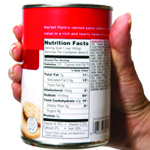When we make a trip to the grocery store, we try our best to make smart purchasing decisions. Whole-wheat bread over white, fat-free cream cheese instead of the ever-so creamy original, and low sodium chips before its salted counterpart. Turns out some of these labels are more deceiving than we think, so we’re here to decode the nutritious terms you read a little too often down the shopping aisles:
All Natural
Sure, a product can be made with real strawberries, but that doesn’t mean it’s not loaded with sugar on top of that. Take popsicles for example, where the label advertises 100% real fruit. In reality, it may contain actual fruit, but chances are it’s packed with preservatives and artificial food colouring too. After all, a strawberry on its own is far less tasty than one coated in sugar. Pst – be wary of baked goods, bagels or cereals that advertise images of fresh fruit on the front of their packages. Many more times than not, the only blue ingredient in a blueberry muffin, is blue food colouring.
Multi-Grain
When a product label has the words multi-grain splashed across the front of its packaging, it means as it sounds: the food contains more than one grain. This, however, reveals nothing about its remaining ingredients. Most products on the market consist of more than one grain anyways, but only some choose to advertise. According to nutritionists, the term doesn’t reveal much about the product itself, and acts as an advertising ploy. So next time you go to grab that box of multi-grain cereal bars from the shelf, make sure you skim the other ingredients as well!
Low Sodium
These days, there are dozens of different sodium labels inscribed on product boxes. From ˜reduced sodium’ to ˜zero sodium’, it’s hard to distinguish one from the other. When a food advertises zero salt, the product still contains sodium. If you spot this label while running errands, keep in mind it only means the product must contain five milligrams of sodium or less. Tip? Don’t sprinkle salt onto anything that is already high in sodium, and keep track of the salt content in the rest of your meals to assure you don’t surpass your daily intake.
Fat-Free
Just as the label zero salt is misleading, turns out the tag free isn’t code for zero either. It only means a product must contain 1.5 grams of fat per 100. Not only that, but manufacturers will replace the fat that’s been removed with sodium or sugar to keep the food tasty, yikes! It’s important to remember that some fats are good for you. A bit of an oxymoron, but a lot of wholesome fats won’t actually make you gain weight, unless you over-indulge. With this in mind, try to avoid anything with trans-fat or high in saturated fats, but don’t narrow your vision to solely purchasing fat-free products; it’s not healthy!
Organic
When people see a product flashing with this label, the first thought that springs to mind, more often than not, is the price. So if you’re about to spend almost twice as much on a product because it’s organic, it’s important to know why. The term means a product has been grown to organic standards, with no artificial ingredients. There is no doubt organic foods are better for the environment (no pesticides!), and treat the animals ethically. From a nutritional perspective however, certain organic products will still contain sugar and fats. In other words, when it comes to calories, an organic chocolate chip cookie is no healthier than a standard baked good.











